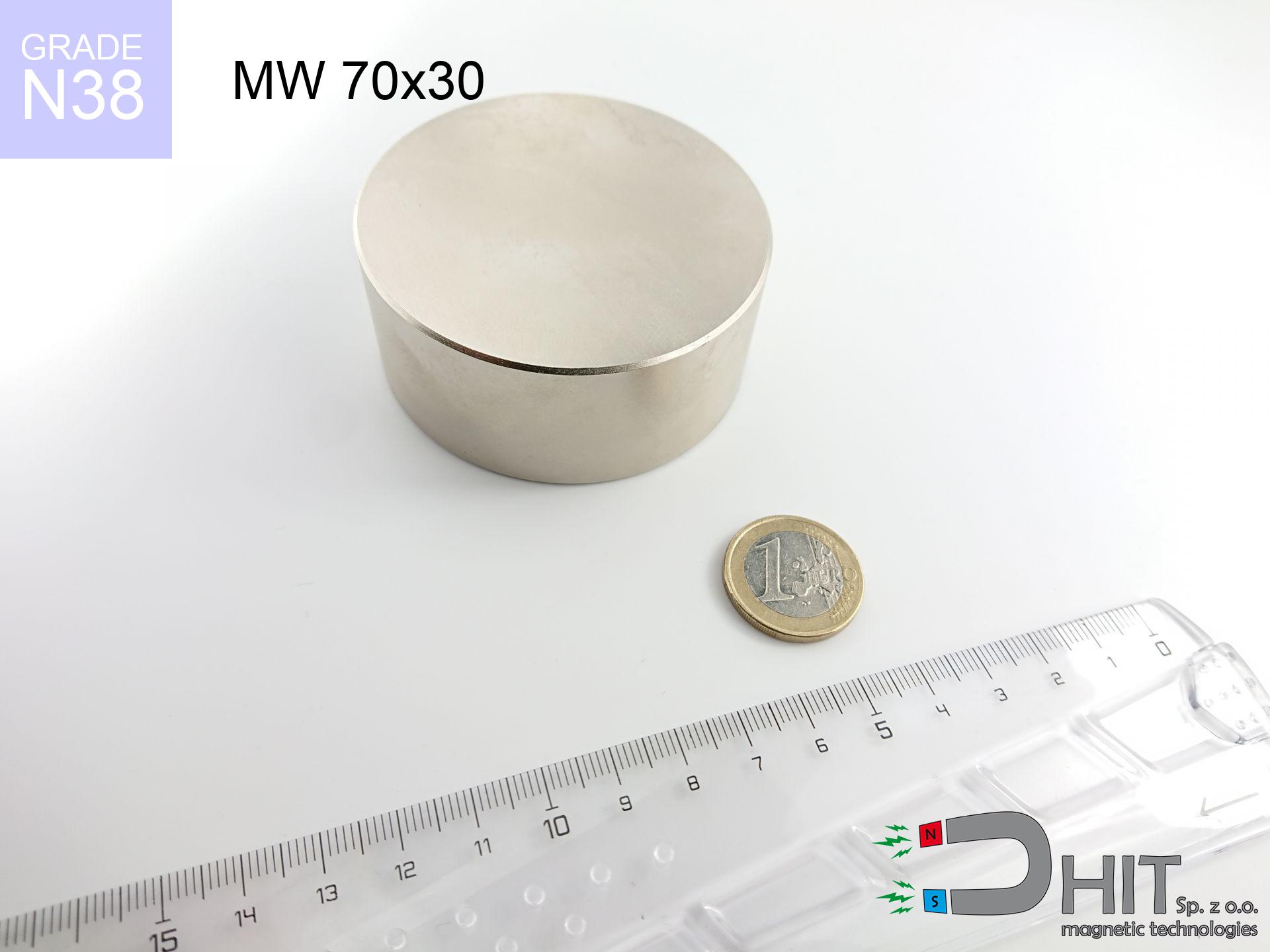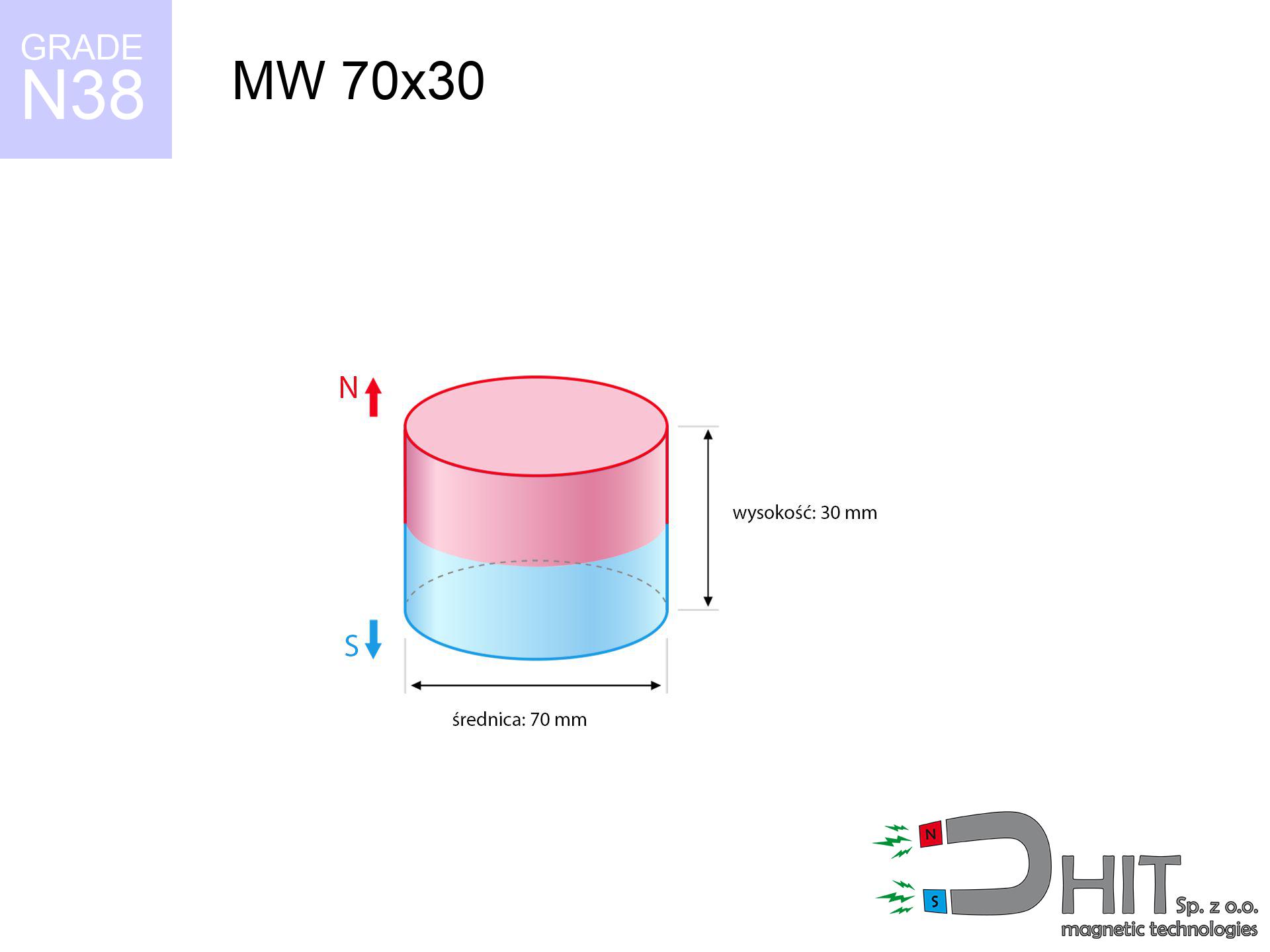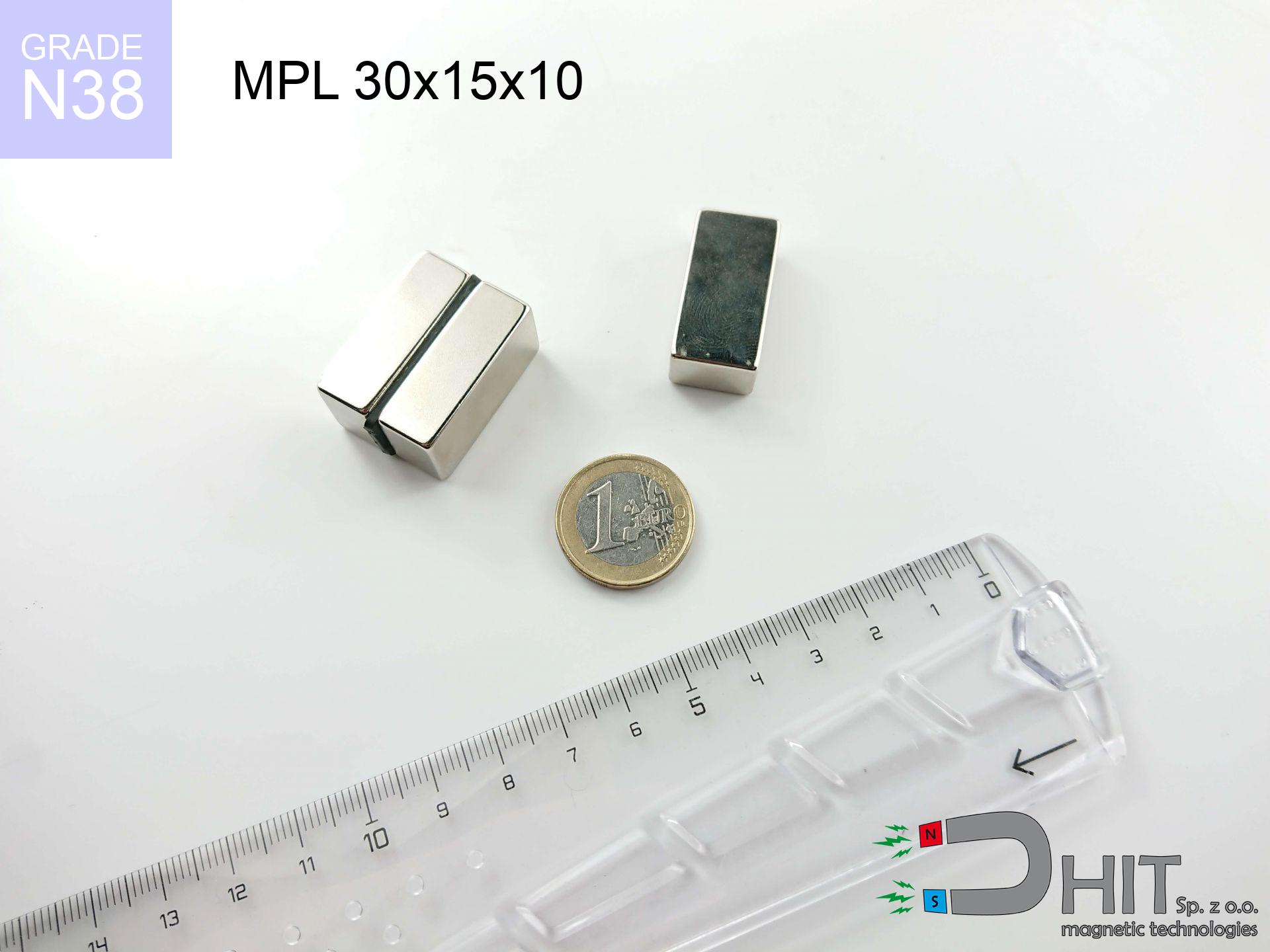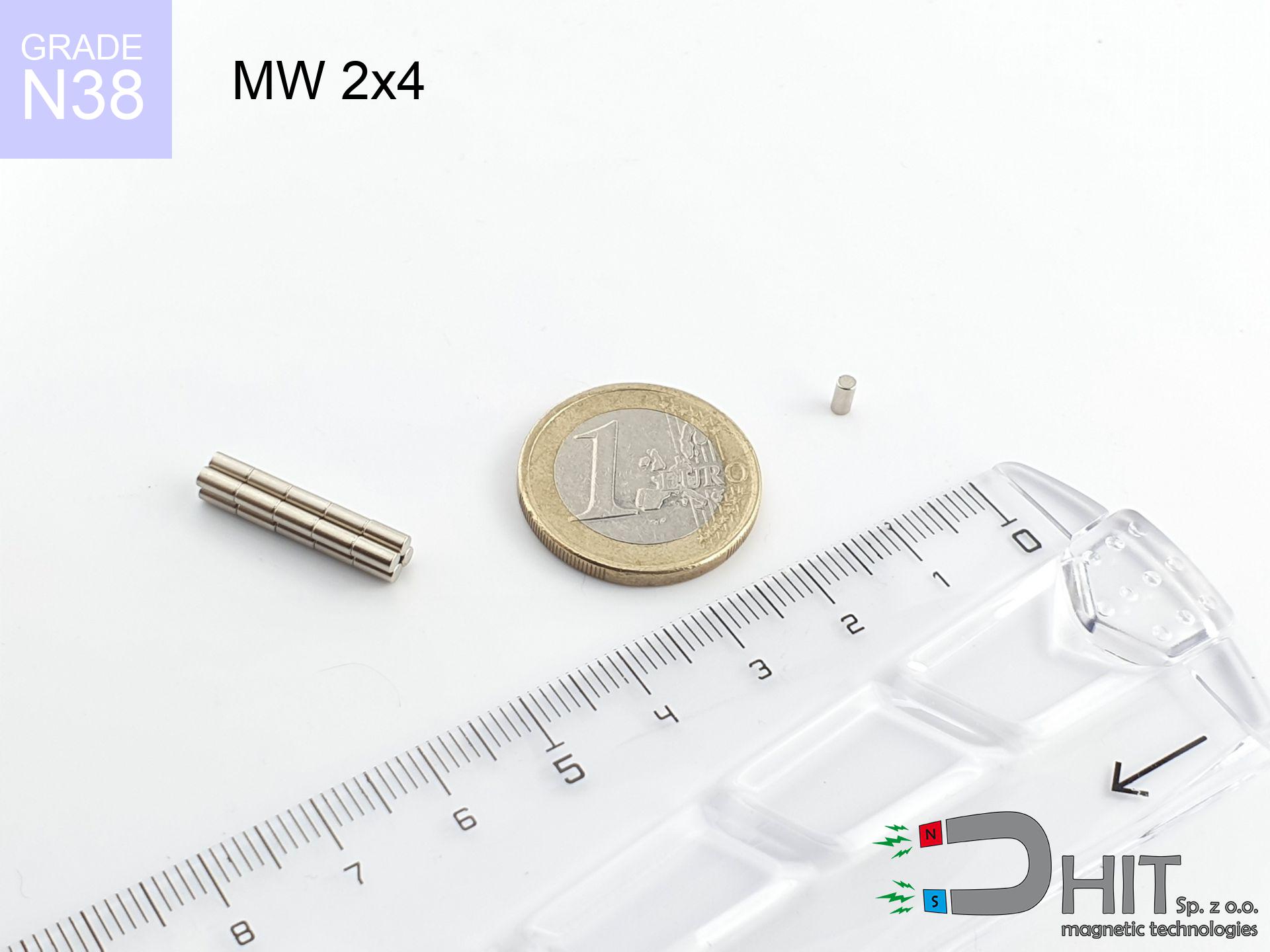MW 70x30 / N38 - cylindrical magnet
cylindrical magnet
Catalog no 010096
GTIN/EAN: 5906301810957
Diameter Ø
70 mm [±0,1 mm]
Height
30 mm [±0,1 mm]
Weight
865.9 g
Magnetization Direction
↑ axial
Load capacity
144.18 kg / 1414.37 N
Magnetic Induction
403.43 mT / 4034 Gs
Coating
[NiCuNi] Nickel
317.17 ZŁ with VAT / pcs + price for transport
257.86 ZŁ net + 23% VAT / pcs
bulk discounts:
Need more?
Give us a call
+48 22 499 98 98
alternatively send us a note via
contact form
the contact page.
Force as well as appearance of magnetic components can be calculated with our
magnetic mass calculator.
Orders placed before 14:00 will be shipped the same business day.
Technical details - MW 70x30 / N38 - cylindrical magnet
Specification / characteristics - MW 70x30 / N38 - cylindrical magnet
| properties | values |
|---|---|
| Cat. no. | 010096 |
| GTIN/EAN | 5906301810957 |
| Production/Distribution | Dhit sp. z o.o. |
| Country of origin | Poland / China / Germany |
| Customs code | 85059029 |
| Diameter Ø | 70 mm [±0,1 mm] |
| Height | 30 mm [±0,1 mm] |
| Weight | 865.9 g |
| Magnetization Direction | ↑ axial |
| Load capacity ~ ? | 144.18 kg / 1414.37 N |
| Magnetic Induction ~ ? | 403.43 mT / 4034 Gs |
| Coating | [NiCuNi] Nickel |
| Manufacturing Tolerance | ±0.1 mm |
Magnetic properties of material N38
| properties | values | units |
|---|---|---|
| remenance Br [min. - max.] ? | 12.2-12.6 | kGs |
| remenance Br [min. - max.] ? | 1220-1260 | mT |
| coercivity bHc ? | 10.8-11.5 | kOe |
| coercivity bHc ? | 860-915 | kA/m |
| actual internal force iHc | ≥ 12 | kOe |
| actual internal force iHc | ≥ 955 | kA/m |
| energy density [min. - max.] ? | 36-38 | BH max MGOe |
| energy density [min. - max.] ? | 287-303 | BH max KJ/m |
| max. temperature ? | ≤ 80 | °C |
Physical properties of sintered neodymium magnets Nd2Fe14B at 20°C
| properties | values | units |
|---|---|---|
| Vickers hardness | ≥550 | Hv |
| Density | ≥7.4 | g/cm3 |
| Curie Temperature TC | 312 - 380 | °C |
| Curie Temperature TF | 593 - 716 | °F |
| Specific resistance | 150 | μΩ⋅cm |
| Bending strength | 250 | MPa |
| Compressive strength | 1000~1100 | MPa |
| Thermal expansion parallel (∥) to orientation (M) | (3-4) x 10-6 | °C-1 |
| Thermal expansion perpendicular (⊥) to orientation (M) | -(1-3) x 10-6 | °C-1 |
| Young's modulus | 1.7 x 104 | kg/mm² |
Physical analysis of the magnet - report
The following information constitute the outcome of a engineering calculation. Values are based on models for the material Nd2Fe14B. Operational conditions might slightly deviate from the simulation results. Treat these data as a preliminary roadmap for designers.
Table 1: Static force (pull vs gap) - power drop
MW 70x30 / N38
| Distance (mm) | Induction (Gauss) / mT | Pull Force (kg/lbs/g/N) | Risk Status |
|---|---|---|---|
| 0 mm |
4034 Gs
403.4 mT
|
144.18 kg / 317.86 LBS
144180.0 g / 1414.4 N
|
crushing |
| 1 mm |
3934 Gs
393.4 mT
|
137.11 kg / 302.27 LBS
137108.9 g / 1345.0 N
|
crushing |
| 2 mm |
3830 Gs
383.0 mT
|
129.96 kg / 286.52 LBS
129962.6 g / 1274.9 N
|
crushing |
| 3 mm |
3724 Gs
372.4 mT
|
122.86 kg / 270.87 LBS
122863.7 g / 1205.3 N
|
crushing |
| 5 mm |
3507 Gs
350.7 mT
|
108.99 kg / 240.28 LBS
108989.8 g / 1069.2 N
|
crushing |
| 10 mm |
2963 Gs
296.3 mT
|
77.77 kg / 171.46 LBS
77773.1 g / 763.0 N
|
crushing |
| 15 mm |
2452 Gs
245.2 mT
|
53.26 kg / 117.41 LBS
53257.6 g / 522.5 N
|
crushing |
| 20 mm |
2003 Gs
200.3 mT
|
35.55 kg / 78.38 LBS
35554.2 g / 348.8 N
|
crushing |
| 30 mm |
1321 Gs
132.1 mT
|
15.45 kg / 34.06 LBS
15450.6 g / 151.6 N
|
crushing |
| 50 mm |
601 Gs
60.1 mT
|
3.20 kg / 7.05 LBS
3199.7 g / 31.4 N
|
medium risk |
Table 2: Sliding hold (vertical surface)
MW 70x30 / N38
| Distance (mm) | Friction coefficient | Pull Force (kg/lbs/g/N) |
|---|---|---|
| 0 mm | Stal (~0.2) |
28.84 kg / 63.57 LBS
28836.0 g / 282.9 N
|
| 1 mm | Stal (~0.2) |
27.42 kg / 60.46 LBS
27422.0 g / 269.0 N
|
| 2 mm | Stal (~0.2) |
25.99 kg / 57.30 LBS
25992.0 g / 255.0 N
|
| 3 mm | Stal (~0.2) |
24.57 kg / 54.17 LBS
24572.0 g / 241.1 N
|
| 5 mm | Stal (~0.2) |
21.80 kg / 48.06 LBS
21798.0 g / 213.8 N
|
| 10 mm | Stal (~0.2) |
15.55 kg / 34.29 LBS
15554.0 g / 152.6 N
|
| 15 mm | Stal (~0.2) |
10.65 kg / 23.48 LBS
10652.0 g / 104.5 N
|
| 20 mm | Stal (~0.2) |
7.11 kg / 15.67 LBS
7110.0 g / 69.7 N
|
| 30 mm | Stal (~0.2) |
3.09 kg / 6.81 LBS
3090.0 g / 30.3 N
|
| 50 mm | Stal (~0.2) |
0.64 kg / 1.41 LBS
640.0 g / 6.3 N
|
Table 3: Wall mounting (shearing) - behavior on slippery surfaces
MW 70x30 / N38
| Surface type | Friction coefficient / % Mocy | Max load (kg/lbs/g/N) |
|---|---|---|
| Raw steel |
µ = 0.3
30% Nominalnej Siły
|
43.25 kg / 95.36 LBS
43254.0 g / 424.3 N
|
| Painted steel (standard) |
µ = 0.2
20% Nominalnej Siły
|
28.84 kg / 63.57 LBS
28836.0 g / 282.9 N
|
| Oily/slippery steel |
µ = 0.1
10% Nominalnej Siły
|
14.42 kg / 31.79 LBS
14418.0 g / 141.4 N
|
| Magnet with anti-slip rubber |
µ = 0.5
50% Nominalnej Siły
|
72.09 kg / 158.93 LBS
72090.0 g / 707.2 N
|
Table 4: Steel thickness (substrate influence) - power losses
MW 70x30 / N38
| Steel thickness (mm) | % power | Real pull force (kg/lbs/g/N) |
|---|---|---|
| 0.5 mm |
|
4.81 kg / 10.60 LBS
4806.0 g / 47.1 N
|
| 1 mm |
|
12.01 kg / 26.49 LBS
12015.0 g / 117.9 N
|
| 2 mm |
|
24.03 kg / 52.98 LBS
24030.0 g / 235.7 N
|
| 3 mm |
|
36.05 kg / 79.47 LBS
36045.0 g / 353.6 N
|
| 5 mm |
|
60.08 kg / 132.44 LBS
60075.0 g / 589.3 N
|
| 10 mm |
|
120.15 kg / 264.89 LBS
120150.0 g / 1178.7 N
|
| 11 mm |
|
132.17 kg / 291.37 LBS
132165.0 g / 1296.5 N
|
| 12 mm |
|
144.18 kg / 317.86 LBS
144180.0 g / 1414.4 N
|
Table 5: Thermal stability (material behavior) - thermal limit
MW 70x30 / N38
| Ambient temp. (°C) | Power loss | Remaining pull (kg/lbs/g/N) | Status |
|---|---|---|---|
| 20 °C | 0.0% |
144.18 kg / 317.86 LBS
144180.0 g / 1414.4 N
|
OK |
| 40 °C | -2.2% |
141.01 kg / 310.87 LBS
141008.0 g / 1383.3 N
|
OK |
| 60 °C | -4.4% |
137.84 kg / 303.88 LBS
137836.1 g / 1352.2 N
|
|
| 80 °C | -6.6% |
134.66 kg / 296.88 LBS
134664.1 g / 1321.1 N
|
|
| 100 °C | -28.8% |
102.66 kg / 226.32 LBS
102656.2 g / 1007.1 N
|
Table 6: Two magnets (attraction) - field range
MW 70x30 / N38
| Gap (mm) | Attraction (kg/lbs) (N-S) | Sliding Force (kg/lbs/g/N) | Repulsion (kg/lbs) (N-N) |
|---|---|---|---|
| 0 mm |
386.08 kg / 851.15 LBS
5 354 Gs
|
57.91 kg / 127.67 LBS
57911 g / 568.1 N
|
N/A |
| 1 mm |
376.71 kg / 830.51 LBS
7 969 Gs
|
56.51 kg / 124.58 LBS
56507 g / 554.3 N
|
339.04 kg / 747.46 LBS
~0 Gs
|
| 2 mm |
367.14 kg / 809.41 LBS
7 867 Gs
|
55.07 kg / 121.41 LBS
55071 g / 540.2 N
|
330.43 kg / 728.47 LBS
~0 Gs
|
| 3 mm |
357.57 kg / 788.30 LBS
7 764 Gs
|
53.63 kg / 118.24 LBS
53635 g / 526.2 N
|
321.81 kg / 709.47 LBS
~0 Gs
|
| 5 mm |
338.48 kg / 746.21 LBS
7 554 Gs
|
50.77 kg / 111.93 LBS
50772 g / 498.1 N
|
304.63 kg / 671.59 LBS
~0 Gs
|
| 10 mm |
291.85 kg / 643.41 LBS
7 014 Gs
|
43.78 kg / 96.51 LBS
43777 g / 429.5 N
|
262.66 kg / 579.07 LBS
~0 Gs
|
| 20 mm |
208.26 kg / 459.13 LBS
5 925 Gs
|
31.24 kg / 68.87 LBS
31238 g / 306.4 N
|
187.43 kg / 413.21 LBS
~0 Gs
|
| 50 mm |
62.81 kg / 138.47 LBS
3 254 Gs
|
9.42 kg / 20.77 LBS
9421 g / 92.4 N
|
56.53 kg / 124.62 LBS
~0 Gs
|
| 60 mm |
41.37 kg / 91.21 LBS
2 641 Gs
|
6.21 kg / 13.68 LBS
6206 g / 60.9 N
|
37.24 kg / 82.09 LBS
~0 Gs
|
| 70 mm |
27.41 kg / 60.43 LBS
2 150 Gs
|
4.11 kg / 9.06 LBS
4112 g / 40.3 N
|
24.67 kg / 54.39 LBS
~0 Gs
|
| 80 mm |
18.35 kg / 40.46 LBS
1 759 Gs
|
2.75 kg / 6.07 LBS
2753 g / 27.0 N
|
16.52 kg / 36.41 LBS
~0 Gs
|
| 90 mm |
12.45 kg / 27.44 LBS
1 449 Gs
|
1.87 kg / 4.12 LBS
1867 g / 18.3 N
|
11.20 kg / 24.70 LBS
~0 Gs
|
| 100 mm |
8.57 kg / 18.89 LBS
1 202 Gs
|
1.29 kg / 2.83 LBS
1285 g / 12.6 N
|
7.71 kg / 17.00 LBS
~0 Gs
|
Table 7: Hazards (electronics) - precautionary measures
MW 70x30 / N38
| Object / Device | Limit (Gauss) / mT | Safe distance |
|---|---|---|
| Pacemaker | 5 Gs (0.5 mT) | 34.5 cm |
| Hearing aid | 10 Gs (1.0 mT) | 27.0 cm |
| Timepiece | 20 Gs (2.0 mT) | 21.0 cm |
| Mobile device | 40 Gs (4.0 mT) | 16.5 cm |
| Remote | 50 Gs (5.0 mT) | 15.0 cm |
| Payment card | 400 Gs (40.0 mT) | 6.5 cm |
| HDD hard drive | 600 Gs (60.0 mT) | 5.5 cm |
Table 8: Collisions (cracking risk) - collision effects
MW 70x30 / N38
| Start from (mm) | Speed (km/h) | Energy (J) | Predicted outcome |
|---|---|---|---|
| 10 mm |
16.84 km/h
(4.68 m/s)
|
9.47 J | |
| 30 mm |
24.00 km/h
(6.67 m/s)
|
19.25 J | |
| 50 mm |
29.50 km/h
(8.19 m/s)
|
29.07 J | |
| 100 mm |
41.18 km/h
(11.44 m/s)
|
56.66 J |
Table 9: Coating parameters (durability)
MW 70x30 / N38
| Technical parameter | Value / Description |
|---|---|
| Coating type | [NiCuNi] Nickel |
| Layer structure | Nickel - Copper - Nickel |
| Layer thickness | 10-20 µm |
| Salt spray test (SST) ? | 24 h |
| Recommended environment | Indoors only (dry) |
Table 10: Construction data (Pc)
MW 70x30 / N38
| Parameter | Value | SI Unit / Description |
|---|---|---|
| Magnetic Flux | 159 225 Mx | 1592.3 µWb |
| Pc Coefficient | 0.53 | Low (Flat) |
Table 11: Submerged application
MW 70x30 / N38
| Environment | Effective steel pull | Effect |
|---|---|---|
| Air (land) | 144.18 kg | Standard |
| Water (riverbed) |
165.09 kg
(+20.91 kg buoyancy gain)
|
+14.5% |
1. Sliding resistance
*Caution: On a vertical wall, the magnet retains just ~20% of its max power.
2. Steel thickness impact
*Thin steel (e.g. computer case) drastically weakens the holding force.
3. Heat tolerance
*For N38 material, the critical limit is 80°C.
4. Demagnetization curve and operating point (B-H)
chart generated for the permeance coefficient Pc (Permeance Coefficient) = 0.53
This simulation demonstrates the magnetic stability of the selected magnet under specific geometric conditions. The solid red line represents the demagnetization curve (material potential), while the dashed blue line is the load line based on the magnet's geometry. The Pc (Permeance Coefficient), also known as the load line slope, is a dimensionless value that describes the relationship between the magnet's shape and its magnetic stability. The intersection of these two lines (the black dot) is the operating point — it determines the actual magnetic flux density generated by the magnet in this specific configuration. A higher Pc value means the magnet is more 'slender' (tall relative to its area), resulting in a higher operating point and better resistance to irreversible demagnetization caused by external fields or temperature. A value of 0.42 is relatively low (typical for flat magnets), meaning the operating point is closer to the 'knee' of the curve — caution is advised when operating at temperatures near the maximum limit to avoid strength loss.
Elemental analysis
| iron (Fe) | 64% – 68% |
| neodymium (Nd) | 29% – 32% |
| boron (B) | 1.1% – 1.2% |
| dysprosium (Dy) | 0.5% – 2.0% |
| coating (Ni-Cu-Ni) | < 0.05% |
Ecology and recycling (GPSR)
| recyclability (EoL) | 100% |
| recycled raw materials | ~10% (pre-cons) |
| carbon footprint | low / zredukowany |
| waste code (EWC) | 16 02 16 |
Other proposals
Strengths and weaknesses of rare earth magnets.
Strengths
- They virtually do not lose power, because even after ten years the decline in efficiency is only ~1% (in laboratory conditions),
- They feature excellent resistance to weakening of magnetic properties when exposed to opposing magnetic fields,
- By covering with a shiny coating of silver, the element acquires an modern look,
- The surface of neodymium magnets generates a maximum magnetic field – this is a distinguishing feature,
- Neodymium magnets are characterized by very high magnetic induction on the magnet surface and can work (depending on the shape) even at a temperature of 230°C or more...
- Thanks to modularity in designing and the ability to customize to client solutions,
- Versatile presence in electronics industry – they serve a role in HDD drives, electric motors, medical devices, as well as multitasking production systems.
- Thanks to efficiency per cm³, small magnets offer high operating force, in miniature format,
Weaknesses
- Brittleness is one of their disadvantages. Upon strong impact they can fracture. We recommend keeping them in a strong case, which not only protects them against impacts but also raises their durability
- Neodymium magnets lose their strength under the influence of heating. As soon as 80°C is exceeded, many of them start losing their force. Therefore, we recommend our special magnets marked [AH], which maintain durability even at temperatures up to 230°C
- They rust in a humid environment - during use outdoors we suggest using waterproof magnets e.g. in rubber, plastic
- Limited ability of producing nuts in the magnet and complicated shapes - recommended is cover - magnetic holder.
- Possible danger to health – tiny shards of magnets pose a threat, in case of ingestion, which gains importance in the context of child safety. Furthermore, tiny parts of these magnets can be problematic in diagnostics medical in case of swallowing.
- High unit price – neodymium magnets have a higher price than other types of magnets (e.g. ferrite), which hinders application in large quantities
Holding force characteristics
Highest magnetic holding force – what affects it?
- on a base made of mild steel, optimally conducting the magnetic field
- whose thickness is min. 10 mm
- with a surface cleaned and smooth
- under conditions of ideal adhesion (metal-to-metal)
- for force acting at a right angle (in the magnet axis)
- at standard ambient temperature
Key elements affecting lifting force
- Gap (between the magnet and the plate), because even a very small distance (e.g. 0.5 mm) results in a drastic drop in force by up to 50% (this also applies to varnish, rust or dirt).
- Loading method – declared lifting capacity refers to pulling vertically. When applying parallel force, the magnet exhibits significantly lower power (often approx. 20-30% of nominal force).
- Base massiveness – insufficiently thick steel does not close the flux, causing part of the power to be wasted to the other side.
- Chemical composition of the base – mild steel gives the best results. Alloy admixtures lower magnetic properties and holding force.
- Surface condition – smooth surfaces ensure maximum contact, which improves force. Rough surfaces weaken the grip.
- Temperature influence – hot environment weakens magnetic field. Exceeding the limit temperature can permanently damage the magnet.
Lifting capacity was assessed with the use of a steel plate with a smooth surface of suitable thickness (min. 20 mm), under perpendicular detachment force, in contrast under shearing force the holding force is lower. Additionally, even a minimal clearance between the magnet and the plate reduces the holding force.
Precautions when working with NdFeB magnets
Compass and GPS
Remember: neodymium magnets produce a field that interferes with sensitive sensors. Maintain a separation from your mobile, tablet, and GPS.
Dust explosion hazard
Powder generated during grinding of magnets is combustible. Avoid drilling into magnets without proper cooling and knowledge.
Danger to the youngest
Absolutely store magnets out of reach of children. Choking hazard is high, and the effects of magnets connecting inside the body are life-threatening.
Operating temperature
Watch the temperature. Exposing the magnet above 80 degrees Celsius will permanently weaken its properties and pulling force.
Conscious usage
Before starting, check safety instructions. Sudden snapping can destroy the magnet or hurt your hand. Be predictive.
Allergy Warning
Allergy Notice: The Ni-Cu-Ni coating consists of nickel. If redness occurs, cease handling magnets and use protective gear.
Protective goggles
Despite the nickel coating, neodymium is delicate and not impact-resistant. Do not hit, as the magnet may crumble into hazardous fragments.
Bone fractures
Mind your fingers. Two large magnets will snap together immediately with a force of several hundred kilograms, destroying everything in their path. Exercise extreme caution!
Life threat
People with a ICD must maintain an safe separation from magnets. The magnetism can disrupt the functioning of the life-saving device.
Protect data
Do not bring magnets close to a wallet, laptop, or TV. The magnetism can irreversibly ruin these devices and wipe information from cards.







![MPL 40x10x4x2[7/3.5] / N38 - lamellar magnet MPL 40x10x4x2[7/3.5] / N38 - lamellar magnet](https://cdn3.dhit.pl/graphics/products/mpl40x10x4x27-3.5-suw.jpg)

